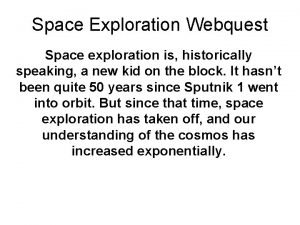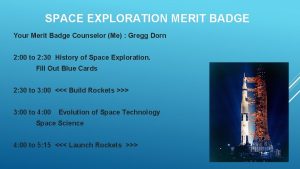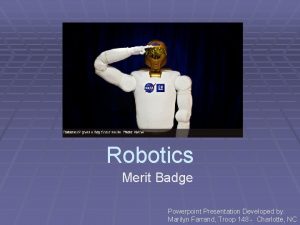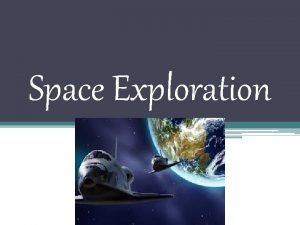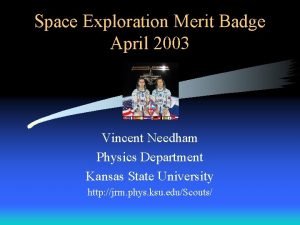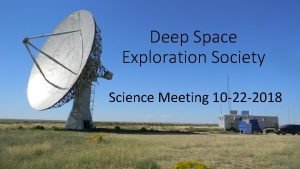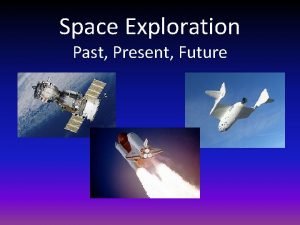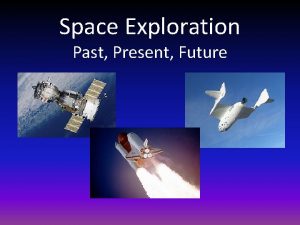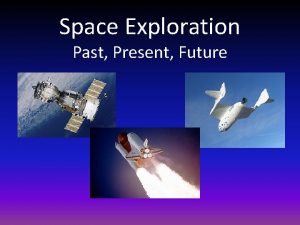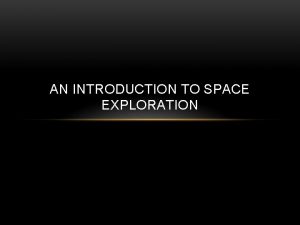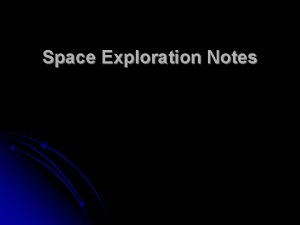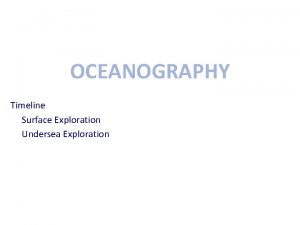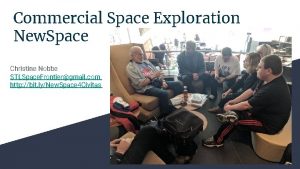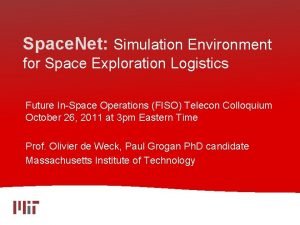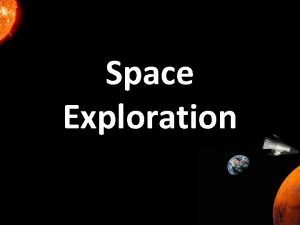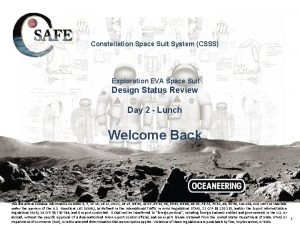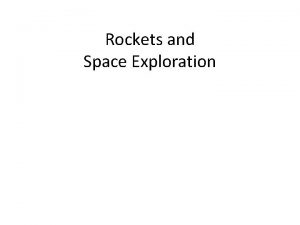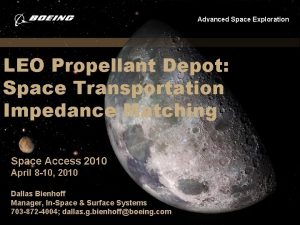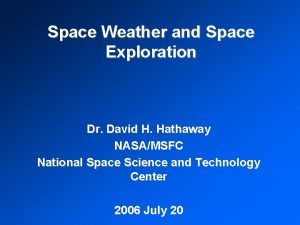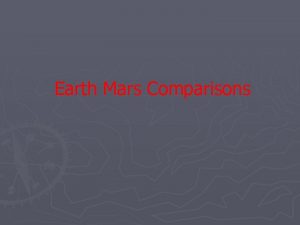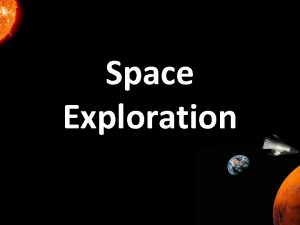Space Exploration http www space com For All











































- Slides: 43

Space Exploration http: //www. space. com/ For All Things Space……. .

Pg. 63 A. What is a Rocket? ► 1. A rocket is a machine that uses escaping gas to move. ► 2. Thrust: the force that accelerates a rocket ► 3. Created by burning rocket fuel ► 4. Burning only occurs w/oxygen, so rockets have to carry fuel & oxygen into space ► 5. Payload: the amt. of material a rocket can carry into space

B. Modern Rocketry 1. Robert Goddard is known as the father of modern rocketry. ► American inventor and physicist ► 2. Launched the first successful liquid fuel rocket in 1926. He tested more than 150 rocket engines. ► By WWII his work became of interest to the US military. ►

Goddard’s First Rocket- “Nell” 3. On March 16, 1926, Goddard finished building a 10 -foot rocket he called Nell, loaded it into an open car and trundled it out to his aunt Effie's nearby farm. ► 4. Traveled upward at 60 m. p. h. ► 5. Altitude of 41 ft. ► 6. Entire flight lasted just 2 1/2 sec. — but that was 2 1/2 sec. longer than any liquid-fueled rocket had ever managed to fly before. ►

Goddard Moves to Roswell New Mexico in 1930. ► Over the next nine years, his Nells grew from 12 ft. to 16 ft. to 18 ft. , and their altitude climbed from 2, 000 ft. to 7, 500 ft. to 9, 000 ft. ► He built a rocket that exceeded the speed of sound another with fin-stabilized steering, and he filed dozens of patents for everything from gyroscopic guidance systems to multistage rockets.

► ► ► By the late 1930 s, however, Goddard grew troubled. He had noticed long before that of all the countries that showed an interest in rocketry, Germany showed the most. Now and then, German engineers would contact Goddard with a technical question or two, and he would casually respond. But in 1939 the Germans suddenly fell silent. With a growing concern over what might be afoot in the Reich, Goddard paid a call on Army officials in Washington and brought along some films of his various Nells. He let the generals watch a few of the launches in silence, then turned to them. "We could slant it a little, " he said simply, "and do some damage. " The officers smiled benignly at the missile man, thanked him for his time and sent him on his way. The missile man, however, apparently knew what he was talking about. Five years later, the first of Germany's murderous V-2 rockets blasted off for London. By 1945, more than 1, 100 of them had rained down on the ruined city.

Rebuffed by the Army, Goddard spent World War II on sabbatical from rocketry, designing experimental airplane engines for the Navy. ► When the war ended, he quickly returned to his preferred work. As his first order of business, he hoped to get his hands on a captured V-2. ► From what he had heard, the missiles sounded disturbingly like his more peaceable Nells. Goddard's trusting exchanges with German scientists had given Berlin at least a glimpse into what he was designing. ► What's more, by 1945 he had filed more than 200 patents, all of which were available for inspection. ► When a captured German scientist was asked about the origin of the V-2, he was said to have responded, "Why don't you ask your own Dr. Goddard? He knows better than any of us. “ ► When some V-2 s finally made their way to the U. S. and Goddard had a chance to autopsy one, he instantly recognized his own handiwork. "Isn't this your rocket? " an assistant asked as they poked around its innards. "It seems to be, " Goddard replied flatly. ►

► 1. Many of Goddard’s ideas were used to design the German V 2 rocket. ► 2. Wernher Von Braun worked for the German military developing the V-2 rocket. ► 3. In 1945 Von Braun and his research team surrendered to the US military and the US gained 127 of the best German rocket scientists. Pg. 65 Germany, WWII and the V-2

4. As part of a military operation called Project Paperclip, he and his rocket team were scooped up from defeated Germany and sent to America where they worked at Fort Bliss, Texas. ► 5. There they worked on rockets for the U. S. Army, launching them at White Sands Proving Ground, New Mexico. ► 6. In 1950 von Braun’s team moved to the Redstone Arsenal near Huntsville, Ala. , where they built the Army’s Jupiter ballistic missile. ► Von Braun’s surrender to the US Army, WWII.

§ 7. Wernher von Braun-German Rocket Scientist (1912– 1977) was one of the most important rocket developers and champions of space exploration during the period between the 1930 s and the 1970 s.

8. In 1960, his rocket development center transferred from the Army to the newly established NASA and received a mandate to build the giant Saturn rockets. ► 9. Accordingly, von Braun became director of NASA’s Marshall Space Flight Center in Huntsville, Alabama, and the chief architect of the Saturn V launch vehicle, the super booster that would propel Americans to the Moon. ► Huntsville, Alabama was home to the facilities the United States government used to develop the country's first space vehicles. ►

Pg. 67 Space Race- US and the Soviet Union 1. October 4, 1957, when the Soviet Union successfully launched Sputnik I. ► 2. The world's first artificial satellite was about the size of a beach ball and took about 98 minutes to orbit the Earth on its elliptical path. ► 3. The public feared that the Soviets' ability to launch satellites also translated into the capability to launch ballistic missiles that could carry nuclear weapons from Europe to the U. S. ► 4. That launch ushered in new political, military, technological, and scientific developments. While the Sputnik launch was a single event, it marked the start of the space age and the U. S. -U. S. S. R space race. ►

Sputnik. First Orbiting Artificial Satellite. Soviet Union-1957

NASA ► 5. The launch of the first satellite, Sputnik, launch led directly to the creation of National Aeronautics and Space Administration (NASA). ► 6. In July 1958, Congress passed the National Aeronautics and Space Act (commonly called the "Space Act"), which created NASA as of October 1, 1958.

Marshall Space Flight Center Huntsville, Alabama ► 7. On January 31, 1958, rocket called a Jupiter-C launched Explorer I, America’s first orbiting satellite. ► 8. 1960 Von Braun became director of NASA’s new George C. Marshall Space Flight Center in Huntsville where he and his team would develop the Saturn rockets that launched astronauts to the moon in 1969.

Explorer 1, First satellite launched by the US. Jupiter C Rocket

Pg. 69 Space Firsts ► 1. First Human in Space- USSR- Yuri Gagarin-April 12, 1961 ► 2. Mercury astronaut Alan Shepard became the first American in space less than a month later. May, 1961 ► 3. On February 20, 1962, NASA launched one of the most important flights in American history. John Glenn became the first American to orbit the Earth and the third human in space.

Saturn V- Apollo 8 and 11 The Saturn V was flight-tested twice without a crew. ► 4. The first manned Saturn V sent the Apollo 8 astronauts into orbit around the Moon in December 1968. ► 5. After two more missions to test the lunar landing vehicle, in July 1969 a Saturn V launched the crew of Apollo 11 to the first manned landing on the Moon. ►

First on the Moon-Apollo 11 - July 1969 ► 6. The US was the first to put a man on the moon. ► 7. Launched on July 16, 1969, it carried Commander Neil Alden Armstrong, Command Module Pilot Michael Collins and Lunar Module Pilot Edwin Eugene 'Buzz' Aldrin, Jr. ► 8. On July 20, Armstrong and Aldrin became the first humans to land on the Moon.



Pg. 71 Space Shuttle ► 1. On January 5, 1972, President Richard M. Nixon announced plans to develop the Space Shuttle for routine access to space. It would be launched like a rocket but would land like an airplane. Until this point, astronauts had to plunge into the ocean on their return from space.

Space Shuttle ► 2. April 12, 1981 marked a new era in the history of space flight. ► The world’s first reusable space vehicle, the Space Shuttle, powered by Marshall developed propulsion systems, was thrust into orbit with two astronauts aboard.

Space Shuttle 3. On April 12, 1981, the Space Shuttle Columbia became the first shuttle to orbit the Earth. ► Flown by Commander John W. Young and Pilot Robert L. Crippen, Columbia spent 2 days aloft on its check-out mission, STS-1, which ended in a smooth landing, airplane-style, at Edwards Air Force Base in California. ►


Shuttle Disasters 4. In 1986, the shuttle Challenger exploded in flight and the entire crew was lost. ► 5. The Space Shuttle Challenger disintegrated 73 seconds into its flight. ► 6. A member of its crew was a civilian and first teacher in space, Christa Mc. Auliffe. ► ► 7. In 2003, while re-entering the Earth's atmosphere, the shuttle Columbia broke up over the United States.

Pg. 73 A. What is a Satellite? http: //www. gma. org/surfing/sats. html ► 1. Although anything that is in orbit around Earth is technically a satellite, the term "satellite" is typically used to describe a useful object placed in orbit purposely to perform some specific mission or task ► We commonly hear about weather satellites, communication satellites and scientific. satellites. ► 2. The path a satellite follows is an orbit.

B. How are Satellites Used? ► ► ► ► Satellites come in all shapes and sizes and play a variety of roles. 1. Weather satellites help meteorologists predict the weather or see what's happening at the moment. 2. Communications satellites allow telephone and data conversations to be relayed through the satellite. 3. Broadcast satellites broadcast television signals from one point to another (similar to communications satellites). 4. Scientific satellites perform a variety of scientific missions. The Hubble Space Telescope is the most famous scientific satellite, but there are many others looking at everything from sun spots to gamma rays. 5. Navigational satellites help ships and planes navigate. 6. Rescue satellites respond to radio distress signals 7. Earth observation satellites observe the planet for changes in everything from temperature to forestation to ice-sheet coverage.

Military Satellites ► Military satellites are up there, but much of the actual application information remains secret. Intelligence-gathering possibilities using high-tech electronic and sophisticated photographic-equipment reconnaissance are endless. Applications may include: -Relaying encrypted communications -Nuclear monitoring -Observing enemy movements -Early warning of missile launches -Eavesdropping on terrestrial radio links -Radar imaging -Photography (using what are essentially large telescopes that take pictures of militarily interesting areas)

C. GPS- Global Positioning System ► ► ► ► When people talk about "a GPS, " they usually mean a GPS receiver. 1. The Global Positioning System (GPS) is actually a constellation of 27 Earth-orbiting satellites (24 in operation and three extras in case one fails). 2. The U. S. military developed and implemented this satellite network as a military navigation system, but soon opened it up to everybody else. They are constantly moving, making two complete orbits in less than 24 hours. These satellites are traveling at speeds of roughly 7, 000 miles an hour. GPS Receivers can be found in newer model cars, airplanes, ships, telephones and in a handheld version. It will pinpoint your location by latitude and longitude. It will show you the direction you are traveling and map out a route you would like to travel.

► A GPS receiver's job is to locate four or more of these satellites, figure out the distance to each, and use this information to deduce its own location. http: //electronics. howstuffworks. com/gps 2. htm

Satellites ► Satellites are used to transmit information as they orbit the Earth. ► They are used in weather, communications, science, navigation and Earth observation. ► GPS satellites (Global Positioning System) allow people to find their location anywhere on Earth and help planes, ships and cars navigate their routes. ► GPS uses 27 Earth orbiting satellites. ► Weather and communication satellites are used daily and are in GEO, Geosynchronous Orbit. ► http: //www. thetech. org/exhibits/online/satellite/ho me. html

Geosynchronous Orbit (GEO) Satellites ► A satellite in geosynchronous (or geostationary) orbit are positioned a fixed point at approx. 21, 000 miles above the earth's surface. ► GEO satellites primary purpose is weather imagery. ► The GEO satellites above the US transmit weather imagery and information to help forecasters relay weather information to us.

LEO (Low Earth Orbit) ► low Earth orbit (LEO) is generally defined as an orbit between 160– 2, 000 km (100– 1, 240 miles) above the Earth's surface. ► Because they orbit so close to Earth, they must travel very fast so gravity won't pull them back into the atmosphere. Satellites in LEO speed along at 17, 000 miles per hour (27, 359 kilometers per hour)! They can circle Earth in about 90 minutes


Space Probes

A. Space Probes 1. Space Probes are used to gather information about distant objects in the solar system. ► 2. They are unmanned vehicles that can reach distances that humans would not be able to reach. ► 3. Space probes are made to conduct science experiments and take photographs. ► 4. Luna 1: The first successful space probe was the Soviet Luna 1 flyby of the Moon in 1959. ►

► Video Clips from the moon. ► http: //history. nasa. gov/alsj/a 11 v_109 2338. mpg ► http: //history. nasa. gov/alsj/a 11 f. 1093 409. mov ► http: //history. nasa. gov/alsj/a 11 f. 1093 543. mov ► http: //history. nasa. gov/alsj/a 11. v 110 0253. mov

Future of the Space Shuttle ► While the space shuttles are a great technological advance, they are limited as to how much payload they can take into orbit. ► The shuttle cannot go to high altitude orbits or escape the Earth's gravitational field to travel to the Moon or Mars. ► NASA is currently exploring new concepts for launch vehicles that are capable of going to the Moon and Mars.

Space Technology in Everyday Life ► NASA’s pioneering research also has produced or contributed to such technologies as satellites, space-based telescopes and cell phones, and new products used every day in every nation that have contributed to advances in health care, transportation, public safety, consumer goods, environmental resources and information technology.

Examples of Space Technology in our Everyday Lives ► MRI Machine-In the mid-1960 s, the Jet Propulsion Laboratory developed digital image processing to allow computer enhancement of moon pictures. Today, digital image processing is used to create and enhance images of body organs in computed axial tomography (CAT scans) and MRI. ► FIRE RESISTANT MATERIAL use in spacecraft materials and spacesuits now used in firefighter suits, homes, race cars and clothes.

More Space Innovations ► ► ► ► Temper foam used in prosthetics (artificial arms and legs). Enriched Baby food Scratch Resistant Lenses Portable coolers Trash compactors Athletic shoes Fogless ski goggles Self-adjusting sunglasses Invisible braces Portable x-ray device Water Purification Cordless Tools Robotic hands To read more about Space Innovations click below: http: //www. thespaceplace. com/nasa/spinoffs. html#chr

Video of asteroid and meteor burning up http: //vimeo. com/59831086
 Dậy thổi cơm mua thịt cá
Dậy thổi cơm mua thịt cá Cơm
Cơm Space exploration webquest
Space exploration webquest Space exploration webquest answer key
Space exploration webquest answer key Benefits stemming from space exploration
Benefits stemming from space exploration The father of modern rocketry
The father of modern rocketry First aid merit badge powerpoint
First aid merit badge powerpoint What are the benefits of space exploration
What are the benefits of space exploration Space exploration merit badge powerpoint
Space exploration merit badge powerpoint Deep space exploration society
Deep space exploration society Name all rays
Name all rays Http //mbs.meb.gov.tr/ http //www.alantercihleri.com
Http //mbs.meb.gov.tr/ http //www.alantercihleri.com Siat.ung.ac.id
Siat.ung.ac.id Fspos vägledning för kontinuitetshantering
Fspos vägledning för kontinuitetshantering Typiska novell drag
Typiska novell drag Nationell inriktning för artificiell intelligens
Nationell inriktning för artificiell intelligens Ekologiskt fotavtryck
Ekologiskt fotavtryck Shingelfrisyren
Shingelfrisyren En lathund för arbete med kontinuitetshantering
En lathund för arbete med kontinuitetshantering Underlag för särskild löneskatt på pensionskostnader
Underlag för särskild löneskatt på pensionskostnader Personlig tidbok fylla i
Personlig tidbok fylla i Anatomi organ reproduksi
Anatomi organ reproduksi Vad är densitet
Vad är densitet Datorkunskap för nybörjare
Datorkunskap för nybörjare Tack för att ni lyssnade bild
Tack för att ni lyssnade bild Mall för debattartikel
Mall för debattartikel Delegerande ledarskap
Delegerande ledarskap Nyckelkompetenser för livslångt lärande
Nyckelkompetenser för livslångt lärande Påbyggnader för flakfordon
Påbyggnader för flakfordon Lufttryck formel
Lufttryck formel Svenskt ramverk för digital samverkan
Svenskt ramverk för digital samverkan Jag har nigit för nymånens skära text
Jag har nigit för nymånens skära text Presentera för publik crossboss
Presentera för publik crossboss Jiddisch
Jiddisch Kanaans land
Kanaans land Klassificeringsstruktur för kommunala verksamheter
Klassificeringsstruktur för kommunala verksamheter Luftstrupen för medicinare
Luftstrupen för medicinare Bästa kameran för astrofoto
Bästa kameran för astrofoto Cks
Cks Verifikationsplan
Verifikationsplan Mat för idrottare
Mat för idrottare Verktyg för automatisering av utbetalningar
Verktyg för automatisering av utbetalningar Rutin för avvikelsehantering
Rutin för avvikelsehantering Smärtskolan kunskap för livet
Smärtskolan kunskap för livet


